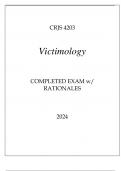Class notes
Chapter 4 - Starting Out With Python Notes w/ Examples
Notes on chapter 4 of Tony Gaddis' Starting Out with Python complete with screenshotted examples of class lectures, both from the textbook and from the professor. Simplified bullet points.
[Show more]







